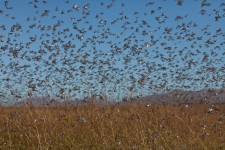Locust Plague Decimating Madagascar’s Crops, Food Supply

The Food and Agriculture Organization (FAO) of the UN has called for $22 million in emergency funding by June to battle a severe locust plague that threatens Madagascar’s next cropping seasons as well as the food security of more than half of the country’s population.
Currently, FAO says that approximately half of the country is infested by the swarms, but reports indicate that two-thirds of the island will be overrun by September of this year if immediate action is not taken.
The infestation, fueled by Cyclone Haruna, which damaged crops and homes and provided optimal conditions for multiple generations of locusts to breed, was carried over from previous years in which the government did not raise enough to treat farm lands effectively. Annie Monard, FAO Senior Officer and Coordinator of the organization’s locust response, likens this issue to not removing the roots of a weed, causing it to simply return the next year with more force.
Crop shortages are anticipated due to the billions of plant-devouring insects, and FAO says that the already food-strapped country could suffer from heightened hunger problems and malnutrition. The plague is currently threatening 60% of the country’s rice production, a staple in the African nation.
The current plan is to launch a three-year $41 million defense. The Ministry of Agriculture plans on launching a full-scale spraying campaign for the first of the three years. Currently, the national Locust Control Centre has treated 30,000 hectares of farmland since the country’s six-month rainy season began in October 2012. 100,000 hectares have been left untreated, though, due to the government’s limited funding.
Additional steps in Madagascar’s plan of action include:
- Aerial and ground survey operations;
- The establishment and training of a Locust Watch Unit inside the PLant Protection Directorate, for monitoring and analysis of the locust situation over the whole invasion area;
- Monitoring and mitigation of locust control operations to preserve human health and protect the environment
- Training in pesticide and spraying operations management.
Normal
0
false
false
false
EN-US
X-NONE
X-NONE
/* Style Definitions */
table.MsoNormalTable
{mso-style-name:”Table Normal”;
mso-tstyle-rowband-size:0;
mso-tstyle-colband-size:0;
mso-style-noshow:yes;
mso-style-priority:99;
mso-style-parent:””;
mso-padding-alt:0in 5.4pt 0in 5.4pt;
mso-para-margin-top:0in;
mso-para-margin-right:0in;
mso-para-margin-bottom:10.0pt;
mso-para-margin-left:0in;
line-height:115%;
mso-pagination:widow-orphan;
font-size:11.0pt;
font-family:”Calibri”,”sans-serif”;
mso-ascii-font-family:Calibri;
mso-ascii-theme-font:minor-latin;
mso-hansi-font-family:Calibri;
mso-hansi-theme-font:minor-latin;
mso-bidi-font-family:”Times New Roman”;
mso-bidi-theme-font:minor-bidi;}





